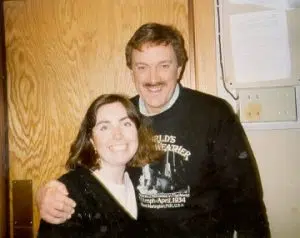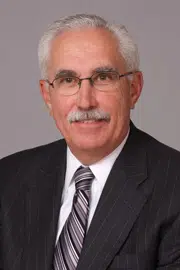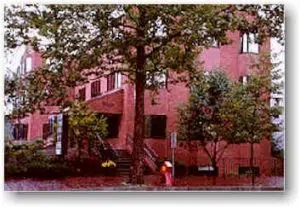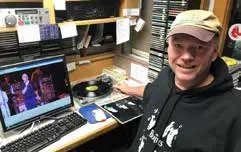|
WILI is located at 720 Main Street, Willimantic, Ct. |
|
We broadcast 24 hours a day at 1400 on the AM dial at a power of 1000 watts, and starting in 2017 we simulcast our AM programming on 95.3 FM. Besides extensive local news, sports and weather programming, we are affiliates of the ABC-Entertainment Radio Network, the Connecticut Radio Network, the UConn/IMG Sports Network, and the World Champion Boston Red Sox Radio Network. We are owned by Hall Communications.
To see a photo album of WILI in the 70’s and 80’s, click here
To see photos and details of WILI’s 50th Anniversary, click here
|

Here’s a bit of WILI History…
WILI first went on the air October 5, 1957. In celebration of our 40th anniversary, Wayne Norman featured an entire week of morning show guests from WILI’s past. Former announcers, newscasters (including former WTIC-TV news anchor Pat Sheehan), and weathermen reflected on the “old” days. And on our 50th anniversary, Wayne had a similar week of shows with alumni. All of those interviews can be heard here and by scrolling down to October, 2007.

WILI’s 40th birthday cake in 1997
October 5, 1957 was a Saturday. WILI was launched with a party at Willimantic’s Capitol Theater by invitation only, sent to leaders of the community. Bill and Mildred Potter, original owners of Potter’s oil, attended along with Mayor Florimand Bergeron.
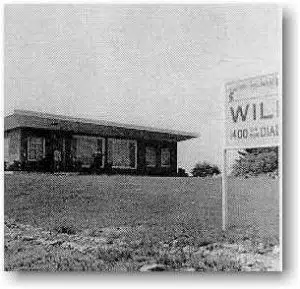

WILI’s original studios were on Route 66 near Windham Airport
WILI was engineered by Donald Howe, a professor of electrical engineering at Worcester Polytechnic Institute. The frequency of 1400 at 250 watts was non-directional. It was chosen because it had been vacated by WICH in Norwich when WICH moved to a regional frequency. But there was a competing applicant–Robert Mensel of Willimantic–who was proposing a daytime-only station at 500 watts on 1430 kHz. The 1400 plan was a tight fit with the FCC’s interference rules at the time. Howe had to construct a test antenna site on the John Pollack farm (our current site near Recreation Park). Howe used a six-foot diameter gas-filled balloon to lift 200 feet of #17 (fine) wire. Nine 200-foot lengths of aluminum wire were used for the ground system. The radiated power was 51 watts on 1200 kHz. With this signal, Howe made the field measurements to prove 1400 would work, and the application won.
The first owners were three French-Canadian businessmen from Central Falls, RI: Goyette, Lanthier, and Cote. They also owned WPCT in Putnam (later WINY) and were in the fuel oil and lumber business in Rhode Island.
Bob Chasse was the radio station engineer when WILI first turned the transmitter on in 1957. His son Michael was born at Windham Hospital about 9:00 the same morning after 30 hours of labor. News Director Les Douglas made the announcement several times that afternoon. Bob’s mother, Flurette, never heard the announcement. Everytime it was made she was out of the car doing an errand. She didn’t find out about it until later in the day by someone else. Bob said “Donald Howe, the installation engineer, was a non-stop worker. He would go anywhere from 12-20 hours non-stop. Then he would flop on a cot for a short nap and start over again.” Bob left WILI in 1958 to become chief engineer at a radio station in Florida, before starting a 35-year career with the FAA, including 27 years in the air traffic control tower in West Palm Beach, Florida.
The late Herbert C. Rice bought WILI in May of 1959. The studios were located on Route 6, at the corner of Airport Road in North Windham. The Lewis Insurance Agency later occupied that building, and a pediatric dentist office is there now. Studios were in the back, and offices were in the front. The station was 250 watts day/night, on the air from 6 A.M. to 11:15 P.M.. On a typical afternoon, the announcer was Ed Read. He worked Noon-6 P.M. Monday through Saturday. Les Douglas was the News Director. He worked a split shift–5 A.M. to noon, then came back for the afternoon shift. Les drove an Edsel. The studio air-conditioner was a window-mounted unit high on the wall close behind the air chair. When you turned on the mic, the a/c was shut off to lower background noise. This encouraged much more music on hot days! The music format was contemporary 45’s with occasional big band oldies from the ’30s and ’40s
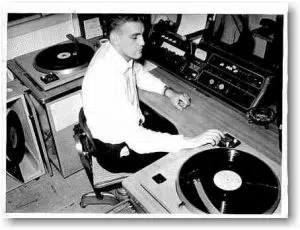
Ed Read at work in the North Windham studios.
Herb Rice was the General Manager and sold advertising. His brother Robert was the Sales Manager. His wife Ethel ran the office and handled billing. All office work was done on mechanical typewriters from scratch every day. The copying process was carbon paper. The production studio had a grand piano which was used occasionally for special programs. A remote was scheduled for July 1960 as Lefty’s Playmore Park was opening for the season. Lefty’s was located where Windham Heights is now. It had a driving range, Roessler’s Yellow Tag hot dogs, Hosmer Mountain Soda, and neighborhood kids on bikes with nothing to do.
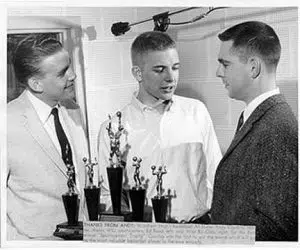

Herb Rice emigrated from Great Britain to Canada at the age of 20. From there he migrated to Boston. Doing what he knew best as the son of a builder, he painted houses, helped re-paint Boston’s legendary Old North Church.
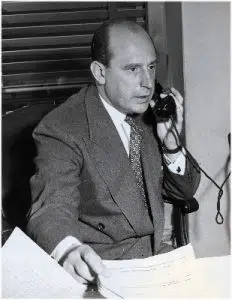

One afternoon in the mid-1920’s he walked into a theater tent, which is now the Cape Cod Music Theater. He found a young woman rehearsing her lines. Herb watched for awhile and, as he tells it, stood up at one point and said, “No, no, no! You must say it with more expression for people to believe you. You’ve got to sell it!” The director said, “Alright, you get up here and show her how it is done!” He did, and was asked to stay on as an assistant. The woman he helped coach was a struggling young actress named Bette Davis.
Herb went on to write and direct many radio dramas and serials, including Bobby Bensen and the B-BAR-B Riders. He needed a blustery big mouth braggart, full of exaggeration, to play the ranch hand. After hours of auditions he selected a young actor named Don Knotts and gave him his first broadcast job, as “Windy Wales.” Knotts played the role so well, the character followed him throughout his career.
Herb met Ethel Kreppel at Buffalo Broadcasting, owner of WKBW, WGR, and WBEN in Buffalo. They married and continued their broadcasting careers together. Herb was impressed with the talents of one of Ethel’s friends from high school. He used him in many radio shows. Eventually this young man branched off and began a television career in the early ’50s. He’s best known as Buffalo Bob Smith, and his show was “Howdy Doody.”
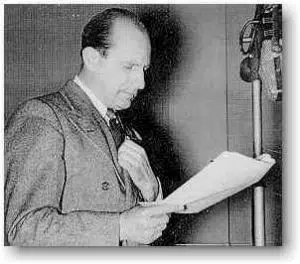
Herb left Buffalo to become the Assistant to the President of the National Broadcasting Company (NBC) in 1945. He joined the Mutual Broadcasting System in New York as Director of Production, and was Vice President of network programs when he left in 1956 to direct film program development for RKO-Tele-Radio.
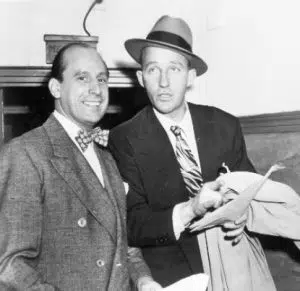

Herb Rice worked with Bing Crosby on a radio show for the USA troops during World War II
Rice owned and managed KVNI in Coeur-d’Alene, Idaho before buying WILI. His wife, Ethel, was also an experienced broadcaster, and a winner of the General Electric National Prize Contest for writing creative advertising copy. In 1994, WILI’s Wayne Norman joined Herb Rice as a recipient of The President’s Medal from Eastern Connecticut State University–one of the school’s highest honors. To hear an interview on the legacy of Herbert C. Rice, click here: https://media.transistor.fm/bfe34c29/2c4b5e7b.mp3


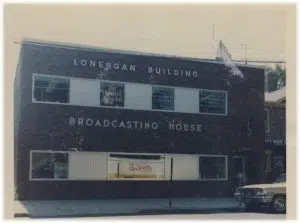

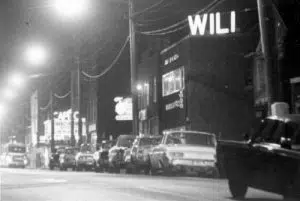

WILI moved to downtown Willimantic at 948 Main Street in 1961. At that time power was increased to 1000 watts day/250 night. The FCC allowed us to broadcast 1000 watts day and night in 1973. The antenna height was doubled to 404′ in 1972. That antenna was upgraded in 2020. We moved to our present location at 720 Main Street on Columbus Day 1987.

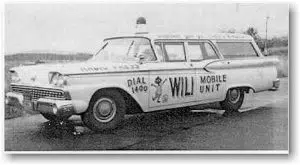
Weather is now a major part of WILI’s program schedule. One of WILI’s first on-air forecasters in 1969 was a UConn student named Wayne Norman. The Southern New England Weather Service was a club of UConn students with an interest in the weather. Using some very primitive equipment, SNEWS offered its services to several radio stations, including WILI. Live conversations with meteorologists began with Norm MacDonald in 1977, and are still an important part of our broadcast day, with Pat Pagano.
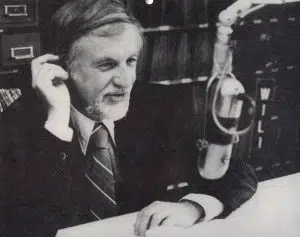

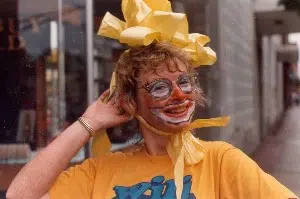 Besides being an outstanding account executive at WILI in the 1980’s and 1990’s, Gail Baker also brightened up WILI Boom Box Parades
Besides being an outstanding account executive at WILI in the 1980’s and 1990’s, Gail Baker also brightened up WILI Boom Box Parades

In the early ’70s, WILI evolved from a Top 40 station into what we called “AM MONO ROCK!” With a large college audience from UConn and ECSU, cuts from best-selling albums became popular. We went three and four cuts deep into albums by artists like Paul McCartney, Boz Scaggs, Carole King, and Fleetwood Mac. Announcers from that era included Terry Ley, William J. Naughton, Tom Watts, Larry Davis, Frank Walker, Bud Fisher, Les Morrell, Paul Christopher, and Dan Hayden, with news by Steve Kotchko, Bill Bruneau, and Jay Johnson (who co-wrote the Elvis classic, “Blue Christmas“).
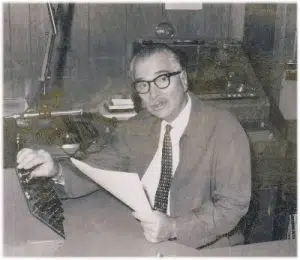
Jay Johnson also did some work on TV
We also produced multi-colored music surveys, with local photos on the cover, including this one, with two of WILI’s sportscasters on the cover (as former WILI jock Tom Lyons once said on air: “Reggie Smith is the one in the middle”).
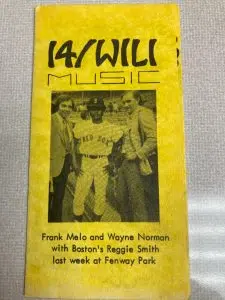
Subsequent WILI News Directors have included Richard Hoffman, Mark Roy, Danny Chun, and Mike Morrissette , who took over in 1990.





Jeff Morrow was WILI’s afternoon meteorologist in the early 1980’s, and had live chats with WILI afternoon announcer Denise Bellamy. Jeff moved to the Weather Channel as an on-camera meteorologist in 1985 and after 27 years at TWC, moved to WKRN-TV in Nashville


William J. Naughton playing records and carts at the WILI studios at 948 Main Street
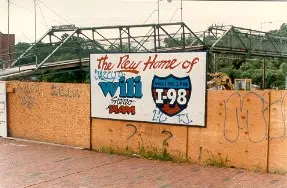


WILI outgrew its 948 Main Street studios in the mid 1980s, and on Columbus Day 1987 moved to new state-of-the-art facilities at 720 Main Street, were we broadcast from today.
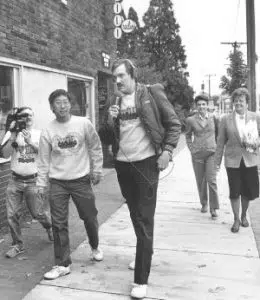

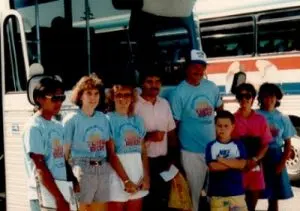

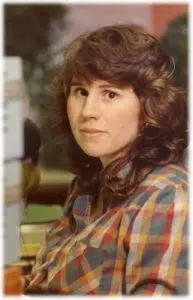
One of the announcers with the longest tenure in the ’80s was Denise Bellamy, who handled the afternoon shift from 1979 to 1985. She did a Saturday morning show in 1983 six hours before her first child was born! Denise moved on to become an Account Executive at WILI.
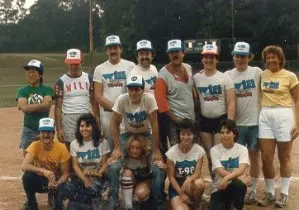
In the early ’80s, WILI aired Wolfman Jack’s syndicated “Graffiti Gold” oldies show.


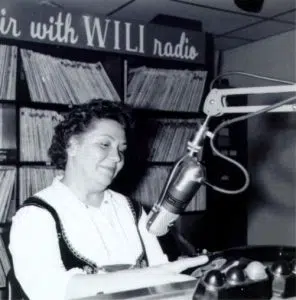
One of our long-time employees was Virginia Seretny, the hostess of “Polka Time” for nearly 40 years, until her passing in May of 2000. To read our tribute to Virginia, click here .
